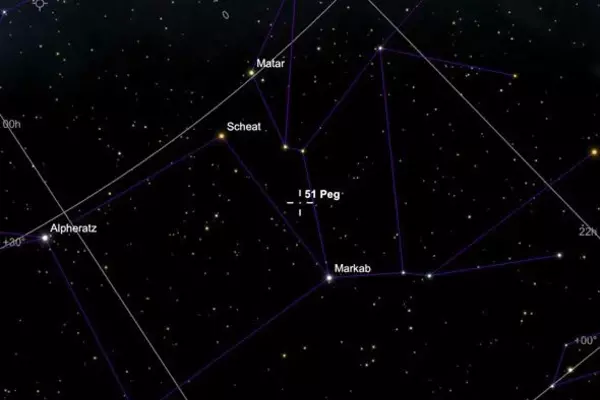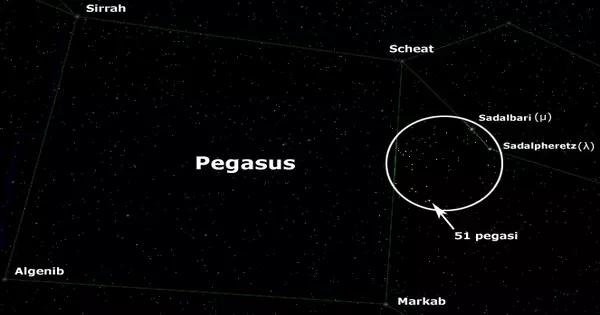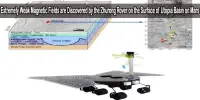51 Pegasi is a Sun-like star in the constellation Pegasus, 50.45 light-years (15.47 parsecs) from Earth. It is a fifth-magnitude star 48 light-years from Earth in the constellation Pegasus, and it is the first sunlike star confirmed to have a planet. It was discovered to have an exoplanet orbiting it as the first main-sequence star. is approximately 50.1 light-years from Sol. It is located northwest of Markab and southwest of Scheat, near the center of the Constellation Pegasus, the Winged Horse. Astronomers announced the discovery of a Jupiter-class planet orbiting this Sun-like star in 1995.
Properties
The apparent magnitude of the star is 5.49, making it visible to the naked eye under ideal viewing conditions. 51 In the 1989 The Perkins catalog of revised MK types for cooler stars, Pegasi was listed as a standard star for the spectral type G2IV. Historically, it was assigned the stellar classification G5V, and it is still listed as a main-sequence star in modern catalogues. It is thought to still be generating energy at its core through thermonuclear fusion of hydrogen, but in a more evolved state than the Sun.
The chromosphere’s effective temperature is approximately 5,571 K (5,298 °C; 9,568 °F), giving 51 Pegasi the characteristic yellow hue of a G-type star. It is estimated to be 6.1 – 8.1 billion years old, slightly older than the Sun, with a 24 percent larger radius and 11 percent greater mass. The star has a higher proportion of elements other than hydrogen/helium than the Sun, which astronomers refer to as a star’s metallicity. Planets are more likely to be found in stars with higher metallicity, such as this one. The rotational period of 51 Pegasi was measured by astronomers Baliunas, Sokoloff, and Soon in 1996.

Despite the fact that the star was suspected of being variable during a 1981 study, subsequent observations revealed virtually no chromospheric activity between 1977 and 1989. A closer look between 1994 and 2007 revealed a similar low or flat level of activity. This, combined with the star’s relatively low X-ray emission, suggests that the star is in a Maunder minimum period, during which a star produces fewer star spots. The star rotates at an angle of 79+11-30 degrees to the Earth.
Nomenclature
Flamsteed’s designation is 51 Pegasi. The star’s planet, and the first exoplanet discovered around a main-sequence star, was named 51 Pegasi b by its discoverers and unofficially dubbed Bellerophon, following the convention of naming planets after Greek and Roman mythological figures (Bellerophon was a figure from Greek mythology who rode the winged horse Pegasus).
The International Astronomical Union launched NameExoWorlds in July 2014, a process for naming exoplanets and their host stars. The new names were chosen through public nomination and voting. The International Astronomical Union named this star Helvetios and its planet Dimidium in December 2015.
Planetary system
On October 6, 1995, Swiss astronomers Michel Mayor and Didier Queloz announced the discovery of an exoplanet orbiting 51 Pegasi. The discovery was made at the Observatoire de Haute-Provence in France. Mayor and Queloz were awarded the Nobel Prize in Physics for their discovery on October 8, 2019.
51 Pegasi b (51 Peg b) was the first discovered planetary-mass companion of a main-sequence parent star. It orbits very close to the star, has temperatures estimated to be around 1,200 °C (1,500 K; 2,200 °F), and has a mass at least half that of Jupiter. This close distance was incompatible with theories of planet formation at the time of its discovery, prompting discussions of planetary migration. However, several hot Jupiters are now known to be oblique relative to the stellar axis.
















